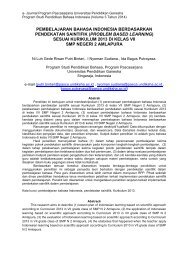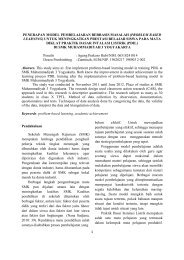Create successful ePaper yourself
Turn your PDF publications into a flip-book with our unique Google optimized e-Paper software.
1 Atomic structure and the periodic table<br />
▲ Figure 1.6 The Statue of Liberty<br />
in New York is coated with a copper<br />
compound which is green.<br />
KEY TERM<br />
Catalyst A substance that speeds up<br />
a chemical reaction but is not used up.<br />
Group 1 – alkali metals<br />
Transition metals<br />
Similarities Conduct heat<br />
Conduct electricity<br />
React with non-metals to form<br />
ionic compounds<br />
Shiny when polished<br />
Differences Low melting points High melting points (except mercury)<br />
Low density<br />
High density<br />
Very soft<br />
Stronger and harder<br />
Very reactive (e.g. with water<br />
and oxygen)<br />
Low reactivity (e.g. with water and oxygen)<br />
Test yourself<br />
React to form 1+ ions<br />
(e.g. Na + )<br />
Compounds are white<br />
Do not act as catalysts<br />
React to form ions with different charges<br />
(e.g. iron forms Fe 2+ and Fe 3+ )<br />
Compounds are coloured<br />
Metals and their compounds are often<br />
catalysts (catalysts speed up reactions but<br />
are not used up themselves)<br />
35 What are the transition metals?<br />
36 List some ways in which the transition metals are similar to the alkali<br />
metals.<br />
37 List some ways in which the transition metals are different from the<br />
alkali metals.<br />
38 What is a catalyst?<br />
◀ Figure 1.7 Margarine is made by reacting plant oils (e.g. sunfl ower oil) with<br />
hydrogen using a nickel catalyst.<br />
Note: A section on History of the periodic table will be included in the<br />
full version.<br />
Mixtures<br />
KEY TERM<br />
Mixture More than one substance<br />
which are not chemically joined<br />
together.<br />
● Mixtures compared to compounds<br />
A mixture consists of two or more substances that are mixed together<br />
and not chemically combined. In a mixture, each substance has its own<br />
properties. Mixtures are very different to compounds.<br />
Description<br />
Compound<br />
A substance made from two or more elements chemically<br />
bonded together. A compound is a single substance with its<br />
own unique properties<br />
Proportions Each compound has a fixed proportion of elements (so<br />
each compound has a fixed formula)<br />
Separation Very difficult to separate compounds back into elements –<br />
it has to be done by a chemical reaction as the elements<br />
are chemically joined<br />
Mixture<br />
Two or more substances each with their own properties<br />
(the different substances are not chemically joined to each<br />
other)<br />
There can be any amount of each substance in the mixture<br />
Easy to separate the substances in a mixture because they<br />
are not chemically joined (and so no chemical reaction is<br />
needed)<br />
20





